- When to Feed Petunia Seedlings
- Wait until the seedlings develop their first true leaves
- Typically, start feeding petunia seedlings two to three weeks after germination
- Monitor the seedlings’ growth and adjust the feeding schedule accordingly
- Choosing the Right Time
- 1. Wait for the seedlings to develop true leaves
- 2. Monitor the growth rate of the seedlings
- 3. Consider the age of the seedlings
- 4. Check the weather conditions
- Signs of Nutrient Deficiency
- 1. Yellowing Leaves
- 2. Stunted Growth
- 3. Leaf Curling
- 4. Weak or Wilted Plants
- 5. Delayed Flowering
- 6. Discolored or Spotted Leaves
- 7. Poor Root Development
- 8. Reduced Tolerance to Stress
- 9. Overall Poor Health
- The Importance of Proper Nutrition
- Feeding Petunia Seedlings: Step by Step
- Types of Fertilizers for Petunia Seedlings
- 1. Organic Fertilizers
- 2. Slow-Release Fertilizers
- 3. Water-Soluble Fertilizers
- 4. Balanced Fertilizers
- 5. Specialized Fertilizers
- 6. Homemade Fertilizers
- Understanding Nutrient Ratios
- Frequency of Feeding
- Early Stage
- Middle Stage
- Late Stage
- Adjustments
- Conclusion
- Common Mistakes to Avoid
- Questions and Answers:
- When is the best time to feed petunia seedlings for the first time?
- What should I feed my petunia seedlings for the first time?
- How often should I feed my petunia seedlings after the first time?
- Can I use organic fertilizer for feeding petunia seedlings?
- What are some signs that my petunia seedlings need to be fertilized?
- Videos: How To Start Vegetable Seeds – The Definitive Guide For Beginners
Feeding petunia seedlings is a crucial step in ensuring their proper growth and development. The first few weeks after germination are a critical period for these young plants, as they require the right balance of nutrients to establish strong roots and healthy foliage. In this comprehensive guide, we will discuss when and how to feed petunia seedlings for the first time, ensuring their long-term success.
Timing is everything
Knowing when to start feeding your petunia seedlings is key to their overall health and vitality. Generally, the first feeding should occur around two to three weeks after germination, once the seedlings have established their first set of true leaves. It is important to note that seedlings can only absorb nutrients once their roots have developed enough to support this process. Keep a close eye on your petunia seedlings and look for signs such as pale leaves or slow growth, as these may indicate the need for nutrients.
Choosing the right fertilizer
When it comes to feeding petunia seedlings, it is essential to choose the right fertilizer. Look for a balanced, water-soluble fertilizer with a ratio of 10-10-10 or 20-20-20, which signifies the percentages of nitrogen, phosphorus, and potassium in the formula. These three major nutrients are essential for plant growth and development. Additionally, opt for a fertilizer that is specifically formulated for seedlings, as it will provide the necessary micronutrients and be easier for the young plants to absorb.
The application process
Feeding petunia seedlings requires a gentle and careful approach. Start by diluting the fertilizer to half of the recommended strength, as young plants are more sensitive to concentrated solutions. Pour the diluted fertilizer into a spray bottle and mist the soil around the base of each seedling, taking care not to wet the foliage excessively. This method ensures a more even distribution of nutrients and reduces the risk of over-fertilization. Repeat this process every two weeks during the seedling stage, gradually increasing the strength of the fertilizer as the plants grow.
By following this comprehensive guide, you can provide your petunia seedlings with the optimal nutrition they need for healthy growth and vibrant blooms. Remember to monitor their progress closely and adjust your feeding schedule and proportions as needed. With proper care and attention, your petunia seedlings will flourish into beautiful and thriving plants.
When to Feed Petunia Seedlings
Feeding petunia seedlings is an important step in their growth and development. Providing them with the necessary nutrients at the right time can help ensure they grow into healthy and vibrant plants. However, it is crucial to know the appropriate time to start feeding your petunia seedlings.
Wait until the seedlings develop their first true leaves
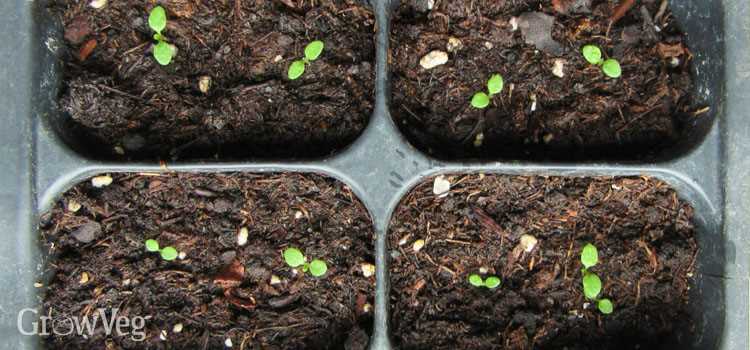
Before feeding your petunia seedlings, it is essential to wait until they have developed their first true leaves. These leaves are different from the initial seed leaves, which are small and do not resemble the mature plant’s foliage. The appearance of true leaves indicates that the seedlings have established a root system and are ready to receive additional nutrients.
Typically, start feeding petunia seedlings two to three weeks after germination
Once your petunia seedlings have developed their first true leaves, it is generally recommended to start feeding them two to three weeks after germination. This timing allows the seedlings to establish a strong root system and minimizes the risk of overfeeding, which can harm their growth.
Monitor the seedlings’ growth and adjust the feeding schedule accordingly
While the two to three-week timeframe provides a general guideline, it is essential to monitor the growth of your petunia seedlings closely. Factors such as growing conditions, potting mix, and fertilizer potency can influence their nutrient requirements. Adjust the feeding schedule accordingly based on the seedlings’ overall health and size.
Remember, it is better to slightly underfeed than overfeed petunia seedlings. Overfeeding can lead to nutrient burn and other detrimental issues. Regularly observe the seedlings’ response to feeding and make necessary adjustments to ensure their optimal growth.
Choosing the Right Time
Feeding petunia seedlings for the first time is an important step in ensuring their healthy growth. However, it is crucial to choose the right time to apply fertilizers to avoid damaging the delicate young plants.
1. Wait for the seedlings to develop true leaves
Before considering feeding petunia seedlings, it is essential to wait until they have developed true leaves. True leaves are the second pair of leaves that appear after the initial cotyledon or seed leaves. These leaves indicate that the seedlings are well-established and ready for nutrient uptake.
2. Monitor the growth rate of the seedlings
Another factor to consider when deciding the timing for feeding petunia seedlings is their growth rate. It is important to observe how fast the seedlings are growing. If the growth is slow or stunted, it might be an indication that they need additional nutrients. However, if the seedlings are growing vigorously and have a healthy green color, it may be better to wait a little longer before feeding them.
3. Consider the age of the seedlings
The age of the petunia seedlings also plays a role in determining the right time for feeding. Typically, it is recommended to wait until the seedlings are two to three weeks old before introducing fertilizers. This allows the plants to establish a strong root system and reduces the risk of fertilizer burn.
4. Check the weather conditions
The weather conditions also influence the timing of feeding petunia seedlings. Ideally, it is best to avoid fertilizing during hot, dry periods as it can stress the young plants. Instead, choose a cool and cloudy day or apply the fertilizer in the early morning or late evening when the temperatures are lower.
By considering these factors, you can determine the best time to feed your petunia seedlings for the first time. Remember to always follow the instructions on the fertilizer packaging and use a balanced formula to provide the essential nutrients for healthy growth.
Signs of Nutrient Deficiency
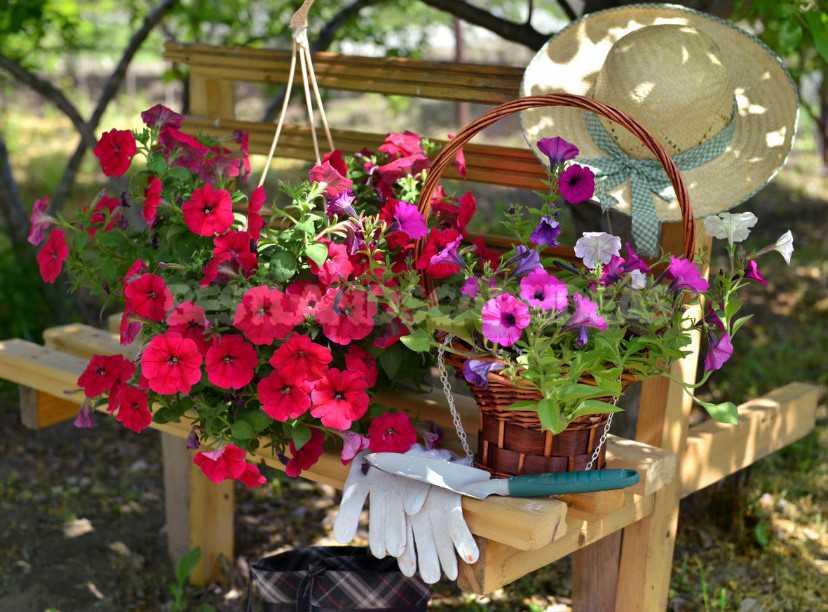
1. Yellowing Leaves
One common sign of nutrient deficiency in petunia seedlings is yellowing leaves. This can indicate a lack of nitrogen, iron, or other essential nutrients. The yellowing may begin at the tips or edges of the leaves and slowly spread throughout the plant.
2. Stunted Growth
Another sign of nutrient deficiency is stunted growth. If petunia seedlings are not receiving enough nutrients, they may struggle to grow and develop properly. The plants may remain small and fail to reach their full potential.
3. Leaf Curling
Nutrient deficiencies can also cause the leaves of petunia seedlings to curl. This curling may occur towards the edges of the leaves, or the entire leaf may curl inward. It can be a sign of various deficiencies, such as potassium or calcium.
4. Weak or Wilted Plants
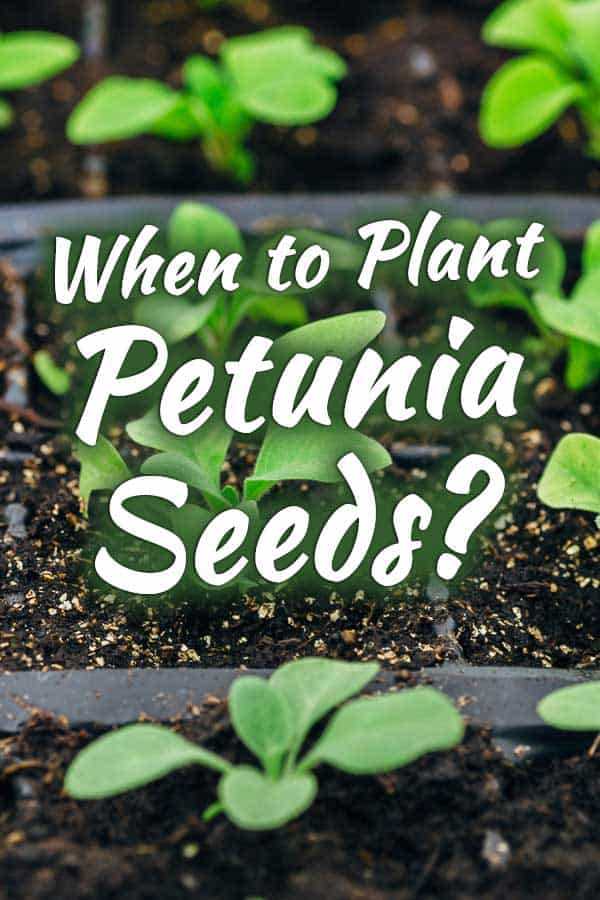
When petunia seedlings lack the necessary nutrients, they may become weak and wilted. The stems may become floppy, and the plants may be unable to support themselves. This can make them more susceptible to diseases and pests.
5. Delayed Flowering
Nutrient deficiencies can also delay the flowering of petunia seedlings. If the plants are not receiving enough nutrients, they may focus their energy on survival rather than producing flowers. This can result in a significant delay in the blooming process.
6. Discolored or Spotted Leaves
Deficiencies in certain nutrients can cause petunia seedling leaves to develop discoloration or spots. For example, a lack of magnesium may lead to leaves with yellow patches or spots. These discolorations may be present on the upper or lower surface of the leaves.
7. Poor Root Development
When petunia seedlings are lacking essential nutrients, their root development may be compromised. The roots may appear weak, shallow, or discolored. This can affect the overall health and vigor of the plants.
8. Reduced Tolerance to Stress
Nutrient deficiencies can weaken petunia seedlings and make them less able to withstand environmental stressors such as extreme temperatures or drought. The plants may become more prone to damage and may struggle to recover from stress.
9. Overall Poor Health
If petunia seedlings are experiencing nutrient deficiencies, they may exhibit overall signs of poor health. This can include a lack of vigor, reduced resistance to diseases and pests, and a general decline in appearance and vitality.
It is important to monitor the health of petunia seedlings and address any signs of nutrient deficiency promptly. Providing adequate nutrition through appropriate fertilization can help ensure the vigorous growth and development of these plants.
The Importance of Proper Nutrition
Petunia seedlings require a steady supply of nutrients in order to grow and thrive. Proper nutrition is essential for their development, as it supports the formation of strong roots, healthy leaves, and vibrant flowers.
When seedlings are provided with the right balance of nutrients, they are better equipped to resist diseases and pests. They are also more resilient to environmental stressors, such as extreme temperatures or drought conditions.
Petunias are heavy feeders and have specific nutritional requirements. They need a fertilizer that is high in phosphorus (P) and potassium (K) but relatively low in nitrogen (N). Nitrogen promotes vegetative growth, which can result in lush foliage but fewer flowers. On the other hand, phosphorus and potassium promote root development, flowering, and overall plant health.
It is important to feed petunia seedlings at the right time. Once they have developed their first set of true leaves, they are ready for their first feeding. This usually occurs around two to four weeks after germination. Starting them on a feeding schedule from an early stage will ensure that they have a consistent supply of nutrients throughout their growing cycle.
There are various options for fertilizing petunia seedlings. One popular choice is to use a balanced, water-soluble fertilizer that can be diluted and applied to the plants every two weeks. This method allows for easy and consistent nutrient uptake. Another option is to use a slow-release fertilizer at the time of planting. This provides a gradual release of nutrients over time, reducing the need for frequent applications.
It is important to follow the manufacturer’s instructions when fertilizing petunia seedlings. Over-fertilization can lead to nutrient burn, causing damage to the roots and leaves. Under-fertilization, on the other hand, can result in stunted growth and poor flower development.
In addition to regular feeding, petunia seedlings also benefit from organic matter in the soil. Mixing compost or well-rotted manure into the planting hole can provide a source of slow-release nutrients and improve soil structure.
In conclusion, proper nutrition is crucial for the healthy growth and development of petunia seedlings. Providing them with the right balance of nutrients at the right time will ensure that they have strong roots, healthy foliage, and abundant flowers. Whether using water-soluble fertilizers or slow-release options, it is important to follow the instructions and avoid over-fertilization. Additionally, incorporating organic matter into the soil can provide long-term benefits for the plants. With proper nutrition, petunia seedlings will be well-equipped to thrive and bring beauty to any garden or landscape.
Feeding Petunia Seedlings: Step by Step
Proper nutrition is crucial for the healthy growth and development of petunia seedlings. Here is a step-by-step guide on how to feed your petunia seedlings for the first time:
- Choose the right fertilizer: Select a fertilizer that is specifically formulated for seedlings, such as a balanced water-soluble fertilizer with a ratio like 20-20-20. Avoid using fertilizer with high nitrogen content, as it can promote leafy growth at the expense of flower production.
- Prepare the fertilizer solution: Dissolve the fertilizer according to the package instructions. Usually, it involves mixing a specific amount of fertilizer with water. Make sure to use the correct ratio to prevent burning the plants.
- Water the seedlings: Before applying the fertilizer, water the seedlings thoroughly. This will ensure that the fertilizer is evenly distributed in the soil and absorbed by the roots.
- Apply the fertilizer: Using a watering can with a fine nozzle or a spray bottle, gently apply the fertilizer solution to the soil around the base of the seedlings. Avoid getting the foliage wet, as it can increase the risk of fungal diseases.
- Follow the recommended frequency: Check the fertilizer package for the recommended frequency of application. Generally, it is advisable to fertilize petunia seedlings every two weeks. However, always adjust the frequency based on the specific needs and growth of your seedlings.
- Monitor the seedlings: Keep a close eye on the seedlings after fertilizing. Look for signs of over or under-fertilization, such as yellowing leaves or stunted growth. Adjust the fertilizer amount or frequency if necessary.
- Water regularly: In addition to fertilizing, it is important to water the petunia seedlings regularly. Adequate moisture is essential for nutrient uptake and overall plant health.
By following these step-by-step guidelines, you can ensure that your petunia seedlings receive the necessary nutrients for optimal growth and vibrant blooms. Remember, healthy seedlings lead to beautiful and thriving petunia plants!
Types of Fertilizers for Petunia Seedlings
Growing healthy and vibrant petunia seedlings requires providing them with the right nutrients at the right time. One way to ensure they receive the necessary nutrition is by using fertilizers. There are various types of fertilizers that can be used for petunia seedlings, each with its own benefits.
1. Organic Fertilizers
Organic fertilizers are derived from natural sources such as animal manure, compost, and plant extracts. They provide a slow-release of nutrients and improve soil structure. Organic fertilizers are eco-friendly and promote healthy growth in petunia seedlings.
2. Slow-Release Fertilizers
Slow-release fertilizers are granular fertilizers that release nutrients slowly over an extended period of time. They are convenient to use as they eliminate the need for frequent applications. These fertilizers are beneficial for petunia seedlings as they provide a steady supply of nutrients.
3. Water-Soluble Fertilizers
Water-soluble fertilizers are easily dissolved in water and can be applied to petunia seedlings through irrigation or foliar spraying. They provide a quick boost of nutrients and are readily absorbed by the plants. This type of fertilizer is ideal for seedlings that require a rapid nutrient uptake.
4. Balanced Fertilizers
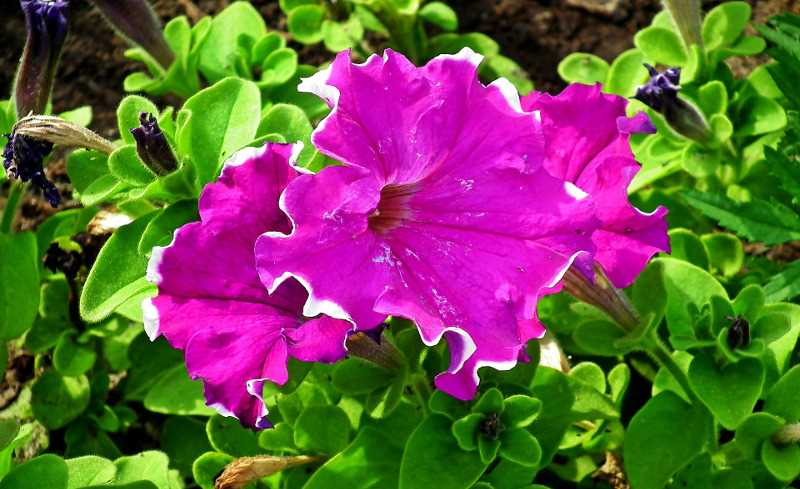
Balanced fertilizers contain a mix of nitrogen, phosphorus, and potassium (NPK) in equal or similar ratios. These fertilizers provide a comprehensive nutrient profile to support overall growth and development. Balanced fertilizers are suitable for petunia seedlings as they promote strong roots, abundant blooms, and healthy foliage.
5. Specialized Fertilizers
Some fertilizers are specifically formulated for certain stages of plant growth or specific nutrient deficiencies. For example, high-phosphorus fertilizers are beneficial during the flowering stage to promote abundant blooms. Specialized fertilizers can address specific needs of petunia seedlings and help them thrive.
6. Homemade Fertilizers
Homemade fertilizers can be made using readily available ingredients such as banana peels, eggshells, or coffee grounds. These fertilizers may not provide a balanced nutrient profile but can supplement the necessary nutrients for petunia seedlings. Homemade fertilizers are often cost-effective and eco-friendly.
When choosing a fertilizer for petunia seedlings, it is important to consider their specific needs, the stage of growth, and the soil conditions. Regular monitoring of the seedlings’ growth and nutrient requirements can help determine the most suitable type of fertilizer to provide optimal nourishment and promote healthy development.
Understanding Nutrient Ratios
When it comes to feeding petunia seedlings, it’s important to understand the nutrient ratios that they require for healthy growth. Nutrient ratios refer to the proportions of different essential elements that are needed for plants to thrive.
There are three primary nutrients that are essential for plant growth: nitrogen (N), phosphorus (P), and potassium (K). These nutrients are often referred to as NPK, and their ratios are represented as three numbers on fertilizer packaging.
The first number represents the percentage of nitrogen, the second number represents the percentage of phosphorus, and the third number represents the percentage of potassium. For example, a fertilizer with a ratio of 10-10-10 contains 10% nitrogen, 10% phosphorus, and 10% potassium.
Each nutrient plays a specific role in the growth and development of petunia seedlings:
- Nitrogen (N): Nitrogen is responsible for promoting strong leaf and stem growth in petunia seedlings. It is necessary for the production of chlorophyll, which is essential for photosynthesis.
- Phosphorus (P): Phosphorus is important for root development in petunia seedlings. It also aids in the transfer of energy within the plant and promotes flower and fruit production.
- Potassium (K): Potassium helps petunia seedlings to withstand environmental stress, such as drought or extreme temperatures. It also plays a role in disease resistance and root development.
When choosing a fertilizer for petunia seedlings, it’s important to select one with a balanced NPK ratio. A ratio of 20-20-20 or 10-10-10 is generally recommended for young seedlings. As the seedlings mature, you may consider adjusting the nutrient ratio to meet their changing needs.
It’s also worth noting that petunia seedlings can benefit from other essential nutrients, such as calcium, magnesium, and trace elements like iron and manganese. These nutrients are often included in specialized fertilizers or can be supplemented separately.
| Nutrient | Role |
|---|---|
| Calcium | Strengthens cell walls, aids in nutrient uptake |
| Magnesium | Essential for chlorophyll production |
| Iron | Important for the production of chlorophyll |
| Manganese | Activates various enzymes involved in growth and development |
By understanding the nutrient ratios that petunia seedlings require and providing them with the right balance of nutrients, you can ensure optimal growth and development.
Frequency of Feeding
Feeding petunia seedlings is an important step in their growth and development. The frequency of feeding depends on several factors such as the age of the seedlings, the type of fertilizer used, and the growing conditions.
Early Stage
During the early stage of growth, petunia seedlings require regular feeding to ensure healthy and vigorous growth. It is recommended to feed the seedlings every two weeks using a balanced liquid fertilizer diluted to half strength. This will provide them with the necessary nutrients to establish a strong root system.
Middle Stage
As the seedlings continue to grow and develop, the frequency of feeding can be increased to once every 10 to 14 days. The fertilizer should still be diluted to half strength to avoid overfeeding the seedlings. It is important to monitor the growth and health of the seedlings to determine if they require more frequent or less frequent feedings.
Late Stage
In the late stage of growth, petunia seedlings may require less frequent feedings. Once the seedlings have reached a certain size and have developed a healthy root system, they will be able to absorb nutrients from the soil more efficiently. It is recommended to feed the seedlings every 3 to 4 weeks using a balanced fertilizer at full strength.
Adjustments
It is important to monitor the growth of the seedlings and make adjustments to the feeding schedule as needed. If the seedlings appear to be growing slowly or showing signs of nutrient deficiency, it may be necessary to increase the frequency of feeding or adjust the strength of the fertilizer. On the other hand, if the seedlings are growing rapidly and look healthy, it may be possible to decrease the frequency of feeding.
Conclusion
Feeding petunia seedlings at the right frequency is essential for their proper growth and development. By providing them with the necessary nutrients at the right time, you can ensure that your seedlings will grow into healthy and vigorous plants.
Common Mistakes to Avoid
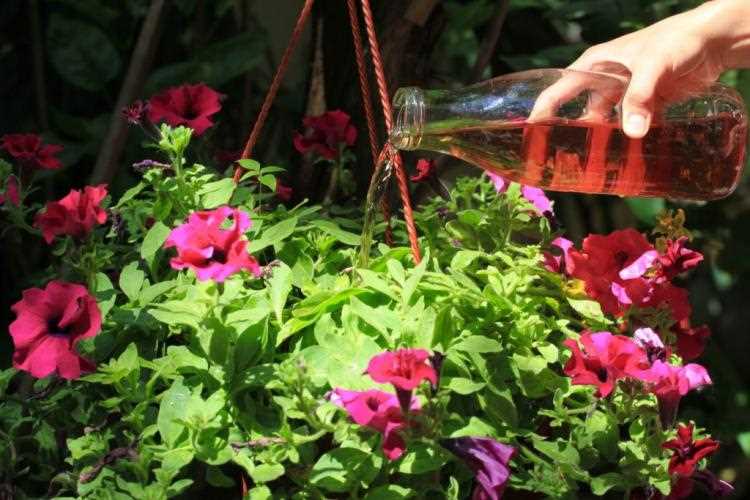
- Overfeeding: One common mistake to avoid is overfeeding your petunia seedlings. While they do need nutrients, giving them too much fertilizer can actually harm their growth. It’s important to follow the recommended dosage and frequency provided by the fertilizer manufacturer.
- Underwatering: Another mistake is underwatering your petunia seedlings. These plants require a consistent supply of moisture to grow properly. Be sure to water them regularly, keeping the soil moist but not waterlogged.
- Transplanting too early: Transplanting your petunia seedlings too early can cause stress and hinder their growth. It’s important to wait until the seedlings have developed a strong root system and a few sets of true leaves before transplanting them into larger containers or the garden.
- Using the wrong soil: Petunia seedlings require well-draining soil that is rich in organic matter. Using the wrong soil mix can lead to poor growth and root rot. It’s recommended to use a high-quality potting mix specifically formulated for seedlings.
- Overcrowding: Planting too many seedlings in a small space can lead to overcrowding, which can negatively impact their growth. It’s important to give each seedling enough space to develop without competition from neighboring plants.
- Not providing enough light: Petunia seedlings require adequate light to grow strong and healthy. Placing them in a location with insufficient light can cause them to become leggy and weak. Consider using grow lights or placing them in a sunny spot indoors or outdoors.
- Ignoring pest and disease control: Petunias can be susceptible to pests and diseases such as aphids, powdery mildew, and fungal infections. Ignoring pest and disease control can lead to stunted growth and plant damage. It’s important to regularly inspect your seedlings for any signs of pests or diseases and take appropriate measures to control them.
By avoiding these common mistakes, you can ensure that your petunia seedlings have the best chance of thriving and growing into beautiful, healthy plants.
Questions and Answers:
When is the best time to feed petunia seedlings for the first time?
The best time to feed petunia seedlings for the first time is when they have developed their first set of true leaves. This is usually around 2-3 weeks after germination.
What should I feed my petunia seedlings for the first time?
For the first feeding, use a diluted balanced liquid fertilizer with an N-P-K ratio of 10-10-10 or 20-20-20. This will provide the necessary nutrients for healthy growth.
How often should I feed my petunia seedlings after the first time?
After the first feeding, you should feed your petunia seedlings every 2 weeks with a balanced liquid fertilizer. This will ensure they receive a continuous supply of nutrients for optimal growth.
Can I use organic fertilizer for feeding petunia seedlings?
Yes, you can use organic fertilizer for feeding petunia seedlings. Look for a liquid organic fertilizer specifically made for seedlings and dilute it according to the instructions on the label.
What are some signs that my petunia seedlings need to be fertilized?
If your petunia seedlings are showing slow growth, pale leaves, or yellowing, it may be a sign that they need to be fertilized. Additionally, if the soil is not rich in nutrients or if the seedlings have been growing for more than 3 weeks without any feeding, it is time to fertilize them.







